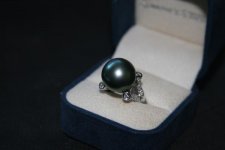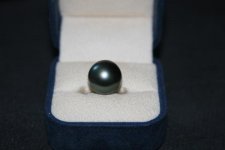Hello,
Where are all the 12 mm and up pearls?
Since the end of 2006, the big Tahitian pearls have little by little disappeared from the market. Do you have any ideas about this?
As a small pearl farmer, I will try to explain the different reason of this mysterious disappearing. I am sorry but my English is a little bit poor.
First of all, let me give you some good hypothesis concerning the Tahitian pearls (and the pearl farming):
1/ Pearl inspection is controlling the pearl layer. It has to be at least at 0.8 mm of thickness everywhere on the surface.
2/ it takes:
+ 2.5 years to get mature oysters ready for the grafting, from the spats. A mature oyster size is 10 to 12 cm of diameter.
+ 18 months from the first operation to a mature pearl
+ 15 months from the second operation to a mature second grafted pearl
3/ for the first operation (or graft), we are usually using 2.2 BU nuclei (1BU= 3.03 mm , so a 2.2 nuclei is around 6.6 mm of diameter)
(BU is a Japanese unit for the nucleus size)
This information is from what I have in the lagoon of Takaroa.
NB: first operation = first graft, second operation = second graft
Knowing that, you can understand the following point:
1/ as a 2.2 nucleus has a diameter of 6.6 mm and as the minimum layer should be 0.8mm per side, so a mature pearl should have the size of: 0.8mm + 6.6mm + 0.8 mm = 8.2mm
So it means that after 18 months, you should have a harvest with most of your pearls with size over 8.2mm
2/ From this point, it also means that the second operation would be with nucleus of 8.2mm (so 2.7BU) and will lead to a second grafted pearl of minimum: 0.8mm + 8.2mm + 0.8mm = 9.8mm (after 15 months)
To summarize:
1st operation gives pearls of 8.2mm and up
2nd operation gives pearls of 9.8mm and up
3rd operation gives pearls of 11.4mm and up
Also, pearls from second operation have less color.
The bigger nuclei are more expensive, so the costs of the 2nd and 3rd operations are higher.
First conclusion:
1/ It is easier to produce smaller size pearls.
Actually, you can even save time if you are using smaller oysters (8cm to 9 cm) and also some smaller nuclei (2.0bu). You will produce pearls of 7.6 mm t least, and the color would be stronger. Percentage of round shape would increase. (nb: smaller oysters are cheaper also)
2/ If the farmer want to have money faster, he can make his harvest after 9 months (instead of 18 months); this will decrease the average size of the pearls in his lot. At the pearl inspection service, he should have more than 5% of rejected pearls (instead of less than 1% usually). But this way, the farmer can almost produce twice the quantity of pearls in the same time.
3/ to save money, the farmer will stop to make second operation and more. (nb: 2n and 3rd operation need a lot of work under the water)
But anyway, this will lead to an over production of very small pearls of 8mm and the number of pearls from 11 mm and up would disappear.
So anytime, the price of the Tahitian pearl is falling, you can be sure that the number of bigger pearls (over 11mm) will decrease one year later.
Robert Wan is a lucky guy; he is the owner of an island called Marutea Sud (or South Marutea); He is the only pearl farmer in this island; for years and years, he could use the wild oysters (those are the oyster who leaves in the corals) that are bigger, so that can accept bigger nucleus (1st operation with 3.0bu nuclei = 10.7 mm pearls at least). So this was a big advantage for him. But today, there are some rumors that said that his natural stock has decreased a lot.
I don?t know if I was enough clear, but I hope that this post has unlighted you to understand why big pearls has disappeared from the market.
If you have any other question, I would be glad to help you.
Bye bye
Marama
Where are all the 12 mm and up pearls?
Since the end of 2006, the big Tahitian pearls have little by little disappeared from the market. Do you have any ideas about this?
As a small pearl farmer, I will try to explain the different reason of this mysterious disappearing. I am sorry but my English is a little bit poor.
First of all, let me give you some good hypothesis concerning the Tahitian pearls (and the pearl farming):
1/ Pearl inspection is controlling the pearl layer. It has to be at least at 0.8 mm of thickness everywhere on the surface.
2/ it takes:
+ 2.5 years to get mature oysters ready for the grafting, from the spats. A mature oyster size is 10 to 12 cm of diameter.
+ 18 months from the first operation to a mature pearl
+ 15 months from the second operation to a mature second grafted pearl
3/ for the first operation (or graft), we are usually using 2.2 BU nuclei (1BU= 3.03 mm , so a 2.2 nuclei is around 6.6 mm of diameter)
(BU is a Japanese unit for the nucleus size)
This information is from what I have in the lagoon of Takaroa.
NB: first operation = first graft, second operation = second graft
Knowing that, you can understand the following point:
1/ as a 2.2 nucleus has a diameter of 6.6 mm and as the minimum layer should be 0.8mm per side, so a mature pearl should have the size of: 0.8mm + 6.6mm + 0.8 mm = 8.2mm
So it means that after 18 months, you should have a harvest with most of your pearls with size over 8.2mm
2/ From this point, it also means that the second operation would be with nucleus of 8.2mm (so 2.7BU) and will lead to a second grafted pearl of minimum: 0.8mm + 8.2mm + 0.8mm = 9.8mm (after 15 months)
To summarize:
1st operation gives pearls of 8.2mm and up
2nd operation gives pearls of 9.8mm and up
3rd operation gives pearls of 11.4mm and up
Also, pearls from second operation have less color.
The bigger nuclei are more expensive, so the costs of the 2nd and 3rd operations are higher.
First conclusion:
1/ It is easier to produce smaller size pearls.
Actually, you can even save time if you are using smaller oysters (8cm to 9 cm) and also some smaller nuclei (2.0bu). You will produce pearls of 7.6 mm t least, and the color would be stronger. Percentage of round shape would increase. (nb: smaller oysters are cheaper also)
2/ If the farmer want to have money faster, he can make his harvest after 9 months (instead of 18 months); this will decrease the average size of the pearls in his lot. At the pearl inspection service, he should have more than 5% of rejected pearls (instead of less than 1% usually). But this way, the farmer can almost produce twice the quantity of pearls in the same time.
3/ to save money, the farmer will stop to make second operation and more. (nb: 2n and 3rd operation need a lot of work under the water)
But anyway, this will lead to an over production of very small pearls of 8mm and the number of pearls from 11 mm and up would disappear.
So anytime, the price of the Tahitian pearl is falling, you can be sure that the number of bigger pearls (over 11mm) will decrease one year later.
Robert Wan is a lucky guy; he is the owner of an island called Marutea Sud (or South Marutea); He is the only pearl farmer in this island; for years and years, he could use the wild oysters (those are the oyster who leaves in the corals) that are bigger, so that can accept bigger nucleus (1st operation with 3.0bu nuclei = 10.7 mm pearls at least). So this was a big advantage for him. But today, there are some rumors that said that his natural stock has decreased a lot.
I don?t know if I was enough clear, but I hope that this post has unlighted you to understand why big pearls has disappeared from the market.
If you have any other question, I would be glad to help you.
Bye bye
Marama



